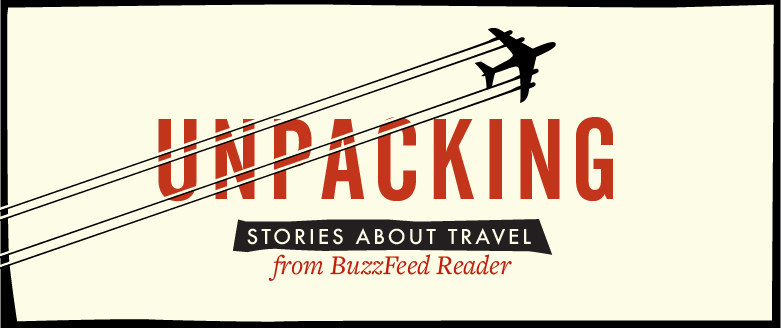My great-uncle’s name felt like a heavy gold token in my pocket. Tomas Fernandez Concepcion. I’d been at the airport for five hours, mostly on the sidewalk of the arrivals terminal looking out for his old blue Volkswagen. Having spent all my change at the pay phone trying and failing to reach him, I had exactly 150 euros in my pocket, and my credit and debit cards weren’t working. At 20, I hadn’t yet learned you had to tell your bank about international travel. I had planned for a smooth arrival and therefore hadn’t seen the need to bring much cash or activate my cell phone. By my third hour on the sidewalk, as night fell, I realized I needed to start crafting a backup plan. By the time the terminal had emptied out two hours later, I realized I needed to use it.
The taxi drivers, once swarming under the evening sun, had dwindled to a quiet few, and the baggage carousels were still. I approached a cabbie in a black leather jacket and asked how much it would cost to get to Rome’s city center. Fifty, he told me. I asked how much the nightly rate was at the cheapest hotel around there. Fifty, he told me. I couldn’t tell if he felt bad for me or was trying to play me, but it didn’t matter at this point. He led me to his car and we drove off.
Traffic was light, and the warm air rushing through my open window dried my sweat. I was still a little disoriented by how quickly the trip had come together, unsure if I’d taken enough time to think it all through. I’d decided to visit my great-uncle just 48 hours earlier, when I was at lunch with my mom, my Auntie Ging, and my cousin Lauren in Vallejo, California. He’d come up during our conversation about former Philippine president Cory Aquino, who had died earlier that week in August 2009. My mom and auntie said that my great-uncle had known her, been friends with her even, and it was then that I got the idea to write a story about him and his reflections on the People Power Revolution, which ushered Aquino into office in 1986, sending dictator Ferdinand Marcos into exile. I hoped to pitch the story to the Filipino community weekly newspaper I’d been freelancing for.
The logistics of a spontaneous trip didn’t seem too complicated. I had no obligations until the fall semester. I’d quit my college football team months earlier to focus on journalism, gotten rejected from all the newspaper internships I applied for, and spent that summer writing unedited stories for obscure publications that sometimes paid and sometimes didn’t. Auntie Ging’s husband, my Uncle Spanky, was a longtime baggage handler with United Airlines. He got me standby tickets through his steep employee discount, and his seniority put me near the top of the waitlist. At the airport the next day, I got lucky, and ended up with one of the two available seats.
Now I was half a world away, off-script, alone, and short on resources. The room at the hotel the taxi driver took me to was small, of course, but it had a bathtub with copper legs and fixtures. As I soaked off the journey, I went through the steps of my backup plan, which was going well so far. My next move was to show up at the Philippine Embassy first thing in the morning. I myself wasn’t born in the Philippines, but I was sure, from what I knew, that my great-uncle was highly respected in the building. A simple mention should bring me a sympathetic audience, guidance on how to reach him, and perhaps even a couch to crash on if another day passed without hearing word. At the American Embassy, I’d be a citizen. But under the flag with the yellow stars and sun, I figured I was community.
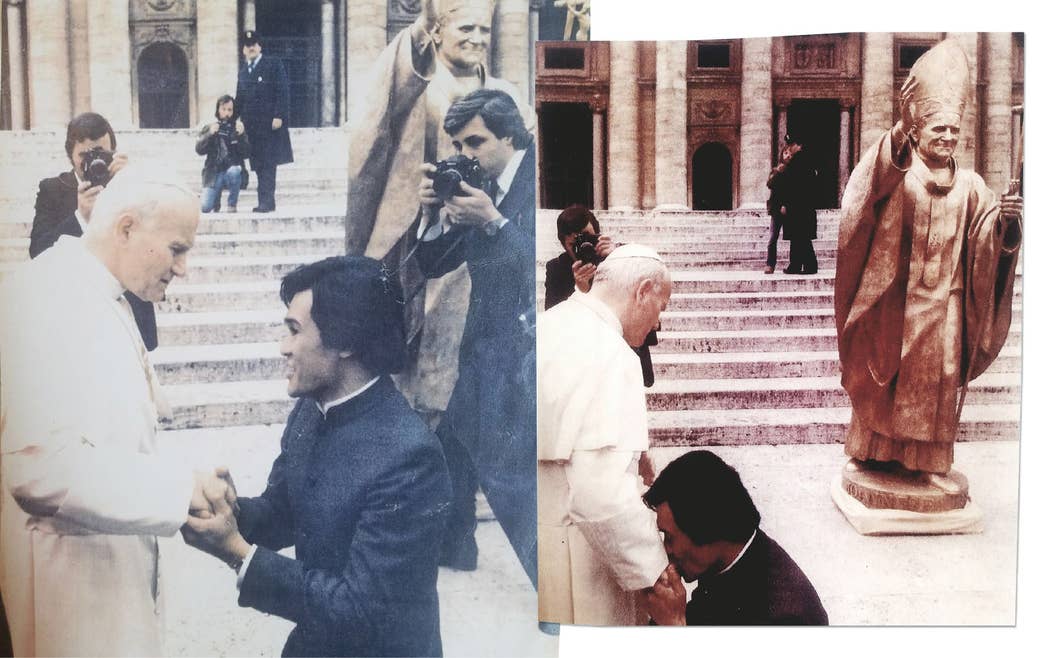
My mother’s uncle was a legendary figure in our family. A famed artist, former revolutionary, and one-term Philippine congressman, he lived in Italy most of his life and my cousins and I rarely saw him, only heard the stories — about the movies he appeared in, the countries he traveled to, the castle he lived in — from aunties and uncles who offered earnest impressions of his slow, forceful baritone. We heard about the famous statues he’d been commissioned to sculpt: two of popes, and one of martyred Philippine senator Ninoy Aquino, which had been flown to Manila in 1984 as the centerpiece of a public demonstration against Marcos. Every household in our family hung a framed photo of my great-uncle bowing before John Paul II at the unveiling of his bronze likeness. “Tomas, you made him more good-looking than me!” Pope John Paul II had joked to my great-uncle, according to family lore.
Tomas had been the only one in our family to stray from the usual diasporic paths laid out for Filipinos leaving the islands. His sister, my great-auntie Caridad, bought a house in San Francisco’s Fillmore District, on Divisadero Street, in 1957. Caridad’s sister-in-law, my grandmother Rizalina, joined her there in 1978 while my grandfather continued working in Manila; my mom and five more of my aunts and uncles followed, arriving in the States in the 1980s and 1990s.
My Auntie Ging, the first among her siblings to arrive, delivered phone books until she found a teaching job. Her husband, my Uncle Spanky, who’d been a famous musician in the Philippines, found work loading trays into airplane kitchens before moving to the tarmac to haul bags. They bought a house 30 miles east of San Francisco, in Vallejo, and it quickly became our family headquarters, a way station for the new arrivals, who cycled through the cozy guest room as they hunted for jobs, working their way toward stability and a home of their own.
He’d gone farther across the world than any of us, and seemed to have found a peace that the rest of us were still chasing.
Every holiday and school graduation, our growing cohort gathered for long meals at pan-Asian buffets or in somebody’s living room. While my cousins and I played, our parents discussed serious matters in hushed Tagalog: pooling money to lend to a struggling household or planning visa applications for those still in the Philippines. We found strength in our numbers, a peace of mind in knowing that, worst-case scenario, there were enough of us to cover for the setbacks of one or two or maybe three.
Over those decades, a continent and an ocean away, my great-uncle Tomas had created a wholly different kind of life for himself outside the warmth of our clan, and the support it offered. He’d gone farther across the world than any of us, and seemed to have found a peace that the rest of us were still chasing.
By the time I was in college, he was in his seventies and lived in a stone villa on a steep hill near the Mediterranean coast, in Tarquinia, a small old town 60 miles north of Rome, lined with narrow cobblestone roads and surrounded by castle walls. I’d visited him once before, five years earlier, with my mom, my Auntie Ging, and my cousin Lauren. My cousin and I were both 15, and it was the first Christmas we’d spent away from the rest of our family in California. Our mothers brought him three cartons of Marlboro Reds and a bottle of E&J brandy, per his request, and he gifted us drawings of each of our zodiac signs depicted as human bodies. He also gave me a strip of nearly expired condoms and an A.S. Roma soccer jersey.
During an evening in Rome, as we ate dinner in a Chinese restaurant Tomas had chosen because it still permitted smoking, he told us stories about his life in Italy. He frequently mentioned Count Sebastiano Bonmartini, his longtime lover, alongside other names we were unfamiliar with at the time — Silvana Mangano, Leontyne Price, Rock Hudson. They were the glamorous characters of our great-uncle’s memories — a history that had been mostly invisible to us, mythic until we’d seen his life assembled around us, behind castle walls, in bronze and paint, photographs and portraits, a scattered timeline that traced back to the point at which our great-uncle diverged from the current that carried the rest of us.
I thought often about that trip. I remember returning to Sacramento, where my mother and I lived in those years, feeling free and light, as if I had stepped outside of myself for the first time, seen the world as it truly existed. I could see the scope of its wonders and eccentricities, unbound from me and indifferent to me: an infinite expanse to explore before time ran out. I wanted to go back; I wanted to go somewhere. I wanted to understand what lay beyond the stable little colony my family had built, out on the endless frontier where my great-uncle had staked his claim. It only occurred to me once I was back in Sacramento, daydreaming in chemistry class, that despite the awe that consumed me as I laid eyes on the castle villa and listened to rousing tales of ’60s Rome, I never asked my great-uncle why he came, or how he managed to plant his flag so deep in soil so far from all he knew.
I knew only one person in the entire country — and he wasn't answering the phone.
Five years later, right after that family lunch in Vallejo in August 2009, I called my great-uncle to ask if I could visit him again. On the phone, after a minute of my loud and repeated enunciations (because his hearing was very bad), he sounded eager to host me: “Oh, wonderful, wonderful; Ric and I will pick you up!” Before I boarded the plane, as I stood at the gate, I called him once more, reminding him through a staticky connection of the arrival details.
Those calls, of course, replayed in my mind as I lay on the hotel room bed, restless with nervous energy. I went outside to wander. With nothing to do but trust that my titos and titas at the Philippine Embassy would take care of me in the morning, I spent most of my remaining euros on pizza and beer, which I ate and drank while sitting at the base of a statue that I guessed to be of St. Michael. Three bottles in, I began considering my options if the backup plan failed.
Did I really expect to walk up to the counter, declare my great-uncle’s name, and have all my problems solved? I’d been born into the comforts of a tight-knit diaspora, the infrastructure and stability my mother’s immigrant generation had built in Northern California, pulling one another up with loans, job offers, places to sleep. I’d always been taken care of, and on the steps below the statue, I realized that I was depending on the same thing happening to me here, in Italy, where I knew only one person in the entire country — and he wasn't answering the phone.
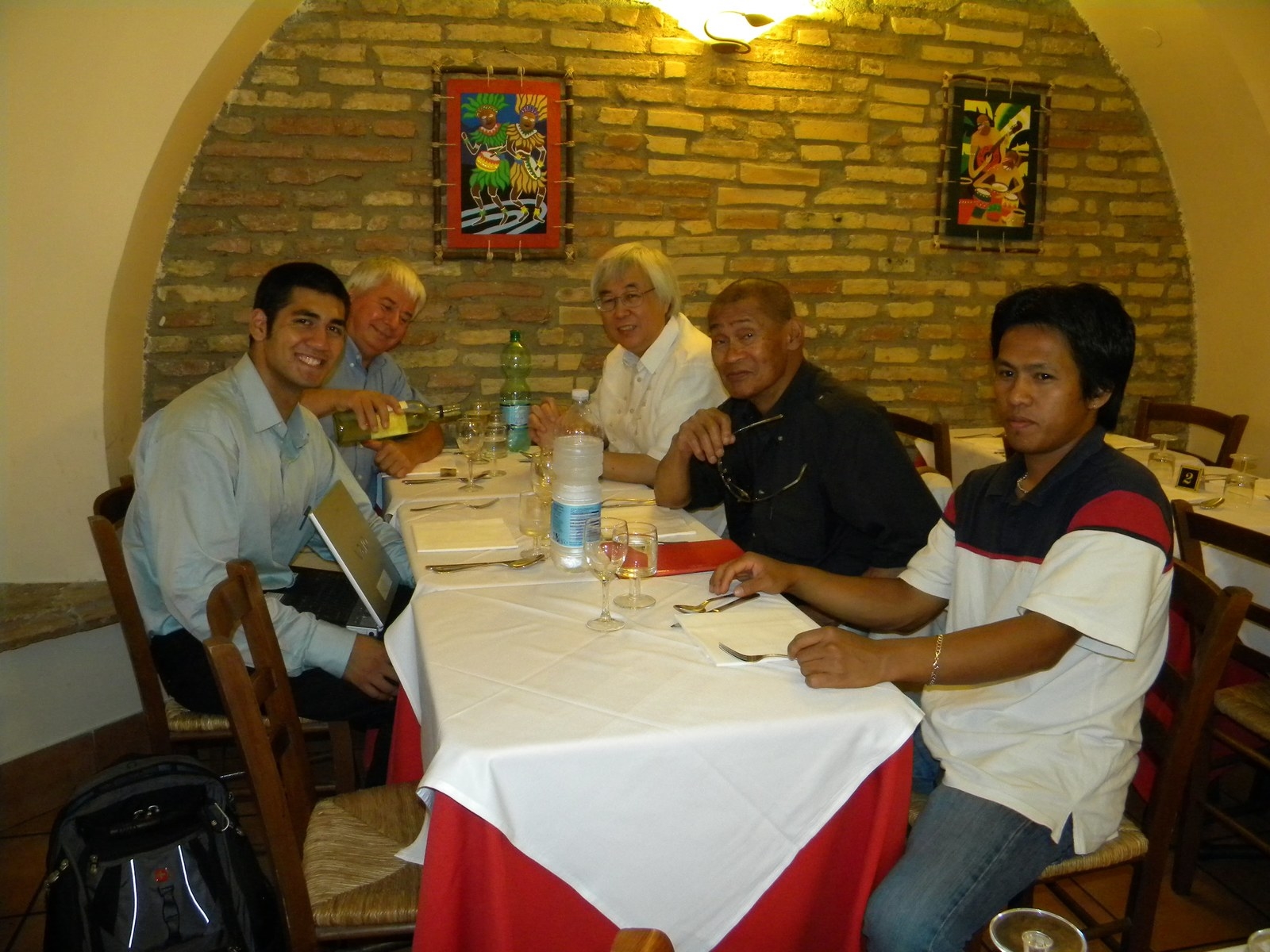
I don’t know what would have happened if I had gone to the Philippine Embassy the next morning. Maybe I really would’ve been rescued by the people who spoke my mother’s language and knew of my great-uncle’s triumphs. But instead, right before checking out of my room, I tried calling Tomas one more time. He hadn’t answered on my three earlier attempts, but this time, he did. An hour later, he and his driver, Ric, arrived at the hotel to pick me up.
The blue Volkswagen slid into an open space up the block. My great-uncle’s brown loafers stepped onto the sidewalk, followed by his wooden cane. He held the car door to pull himself up and shuffled toward me, slowly and gingerly, his back hunched but his head up, his eyes alert, a regal grin on his face.
“Welcome, Albert!” he boomed, then chuckled deeply. “I’m glad we finally found each other!”
He wore white pants, a dark blue safari shirt, and gold-rimmed aviator sunglasses — a casually chic style I didn’t appreciate at the time, because I didn’t know how to dress back then. We embraced, patting each other’s backs. Ric greeted me with a nod, put my duffel bag in the trunk, and wove the car expertly through the bustling streets, loud with high-pitched honks and the whirring of motor scooters. Ric was a 27-year-old Filipino with thick calves and wavy hair. He’d worked for Tomas for three years and sent most of his paycheck to his wife and kids, who lived in a rural province of the Philippines. He hoped to retire there one day with the euros he was saving. For him, Italy was a temporary stop, a job, a sacrifice he made for the good of his family.
Ric spoke only Tagalog, which I understood, and I spoke only English, which he understood. My great-uncle spoke both, as well as Italian, but we had to enunciate loudly, clearly, and with repetition for Tomas to hear our words. We never did figure out what had happened at the airport. They had been there at the right time, it turned out, but we didn’t bother to try to solve the mystery of how we hadn’t connected. There was so much else to discuss.
From the car, Tomas pointed out the piazza where he’d organized a rally against Marcos, and the cafe where he’d convened with Italian politicos who supported his cause. I scribbled notes from the backseat, asking questions.
“Has the city changed much since you first lived here?” I asked. Tomas looked straight ahead, a cigarette loosely dangling from his fingers, smoke snaking out his half-open window. I asked again, nearly shouting, leaning in closer to his ear, “Have you seen the city change much?”
“It’s a beautiful city, isn’t it?” he replied, turning toward me. “A beautiful city! You know, it was here I fell in love with Michelangelo — my hero, you know — but I did not know anybody. I had to make my way. I thought I would be here for only a short time. But once I was here I did not want to leave!” He let out a warm, slow, thunderous laugh, like if Santa had smoked a pack a day for five decades. “I think I was the only Filipino in Italy for quite some time!”
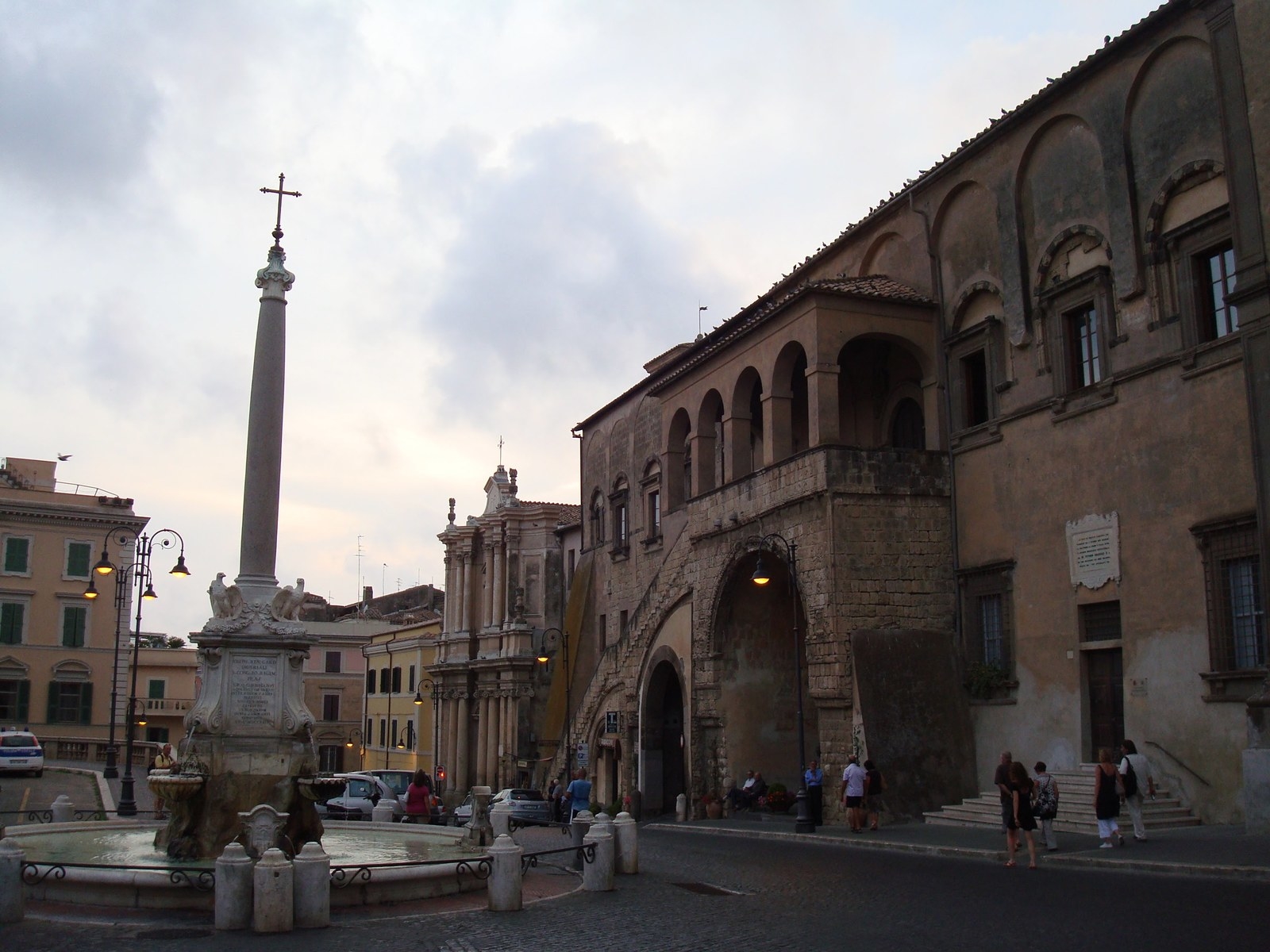
An hour later, we were in Tarquinia. Tomas’s villa lay beside a church on the town’s northern tip, at the base of a 30-foot turret, behind high stone walls and a solid iron door — the property had once been part of a bishop’s fortified compound. The cinderblock cottage had a red shingle roof, and the yard stretched to the castle wall, perched at the edge of a ridge overlooking green and amber hills. From the back patio, the only sounds you heard were chirping birds and clanging church bells.
The cottage was bright with sunlight and cluttered with a lifetime’s accumulation of achievements — artwork he’d completed or abandoned tucked into every available space, sculptures on stools and stacks of canvasses leaning against walls, a table covered with bottles of paint and jars of brushes, a couch weighed down with books. Next to the windows, in the center of the room, a gold frame held a portrait of his lover Sebastiano, who had inherited this castle villa and died in 1997, granting Tomas the property for the rest of his life. Below that, between his desk and the kitchen, was his sculpting workspace: a box of small metal tools, a swivel chair, a wooden board on a rusty stand, and a clay form cloaked under a plastic bag. A few of his seven Belgian shepherds scurried around us.
Cigarette between his lips, Tomas unbuttoned his shirt, untucked his tank top, and tapped a long pole of ash into the glass tray on his desk. From decades of molding clay, his fingers were slanted at terrifying angles. The tips of his thumbs veered outward, away from the rest of his hand. His other fingers leaned the opposite direction, like lanes curving around the bend of a racetrack.
“I’ve started a new bronze,” he said, pulling the plastic bag off the clay form.
Though the work was not complete, I recognized the face of the 44th president instantly. He’d been working on it for nearly three weeks, he said, and he hoped to send it to Washington, DC, as a gift to Barack Obama.
In the mornings, afternoons, and into the evenings he shaped the Obama head while I sat nearby, asking more questions. We spent our first few hours discussing the 1986 revolution and its aftermath, the material I needed for the story I was writing: his secretive visits to Manila for opposition gatherings after Marcos declared martial law; his years as the congressional representative for overseas Filipino workers, a job that shuttled him around the world to investigate reports of abuse; his conversations with presidents and monarchs.
“I kept getting pulled into politics!” he said, raising his voice, gesturing his hands like a symphony conductor, an inch of ash precariously hanging from his cigarette, somehow not breaking off even as he took another deep drag. “The more revolution I was making, the less art I made. I just want to be an artist! But how can I say no?”
When Sebastiano died, Tomas was left alone in the castle villa. He retired from politics months later. Though he still owned a studio in Rome, he began spending less time there, preferring the solitude and space of the countryside.

He was renowned for his bronze sculptures, which seemed to capture moments of furious movement frozen in time, often anguished faces on yearning bodies. His most famous piece, titled “The Prisoner,” depicted a man on his knees, leaning back, hands bound to his ankles, face twisted with grief, eyes searching the sky. As I watched, he worked on the Obama bust patiently and diligently, smoothing the moist gray clay, silently staring at his creation for minutes before reaching out his thumb to make an alteration imperceptible to my eyes, a process repeated with painstaking precision.
“When does it become bronze?” I asked.
He explained that the clay would be cast into a mold, and then the mold filled with molten metal. Once cooled, the mold would be cracked open, revealing the final product.
“A bronze will last very long,” he said. “That has always appealed to me. It is nice to make something that will last.”
His bronzes were all over the villa: slender standing bodies in the driveway, busts on podiums on the patio, athletic figures in the yard that cast eerie silhouettes against the night sky. He worked at a furious pace, and his energy was contagious.
During breaks from our interviews, I wrote almost constantly — short stories, rap verses, and ideas to pitch to my campus paper, filling dozens of pages a day in my blue spiral notebook. Some mornings I walked around town, taking photos, stopping on benches to scribble notes. One evening, I crossed the yard and climbed the stone steps to the top of the castle wall to watch an opera being performed in the church courtyard down below. Sitting in the dark, I typed my notes on my BlackBerry. When Tomas saw me up there, he bellowed, “You should have told me you wanted to watch the opera — I would have gotten tickets to one in Rome!”
Those days and nights were fun as hell, man. I stayed up late. I read outside. I drank limoncello. I smoked my first cigarette, one day after lunch on the patio. Freshly released from the prohibitions of my wholesome athlete days, I was eager to indulge, although I was still getting used to it. A few months earlier, I had run into the star quarterback from my freshman year. He had graduated to the NFL, and was back at school visiting.
I hadn’t properly considered the distinction — the chasm between those who find the life they are searching for in the strength of the unit, and those who stray to find it.
“Daaang, Samaha, you don’t play no more?” he said, disappointment all over his face. “Gotta play till your legs fall off.” That crushed me, because I’d held that same conviction for so long, and hadn’t yet escaped its pull. But those old loyalties felt distant in Tomas’s quiet corner of the world, where each day’s purpose was clear, exhilarating, open-ended. It was the great blessing, and freedom, of time devoted to the work that fulfills you most.
I had heard the stories of my great-uncle’s life for so long that they’d been polished to a sheen of inevitability: He had landed in Italy, just as the rest of us had landed in California. But I hadn’t properly considered the distinction — the chasm between those who find the life they are searching for in the strength of the unit, and those who stray to find it.
“Why did you decide to go to Italy?” I asked.
“Oh, I knew I had to go to Rome,” he said. As always, his words seemed to launch from deep in his chest, forging an urgency even as he spoke slowly, calmly. “I had heard so much about it. The art. The romanticism! You know, every city, when it appears over the horizon for the first time, shows itself in a particular way. But my train arrived in Rome very late. I slept through that magical moment! I didn’t even know where I was going to stay that night, Albert. I had no one to call and not much money in my pockets. The only Italian words I knew were spaghetti and pizza!” He chuckled heartily, sipped, smoked. “In fact, let me show you what I have written.”
He went to his desk and returned with a stack of papers bundled together with a rubber band. It was a short memoir about his years in Italy that he’d written and published in Italian, then had translated into English through a computer software. He was disappointed in this translation, which was very crude and in some parts unreadable. Over the next few days, we went over the pages, him retelling the stories, me rewriting them. He’d titled the book A Stranger.
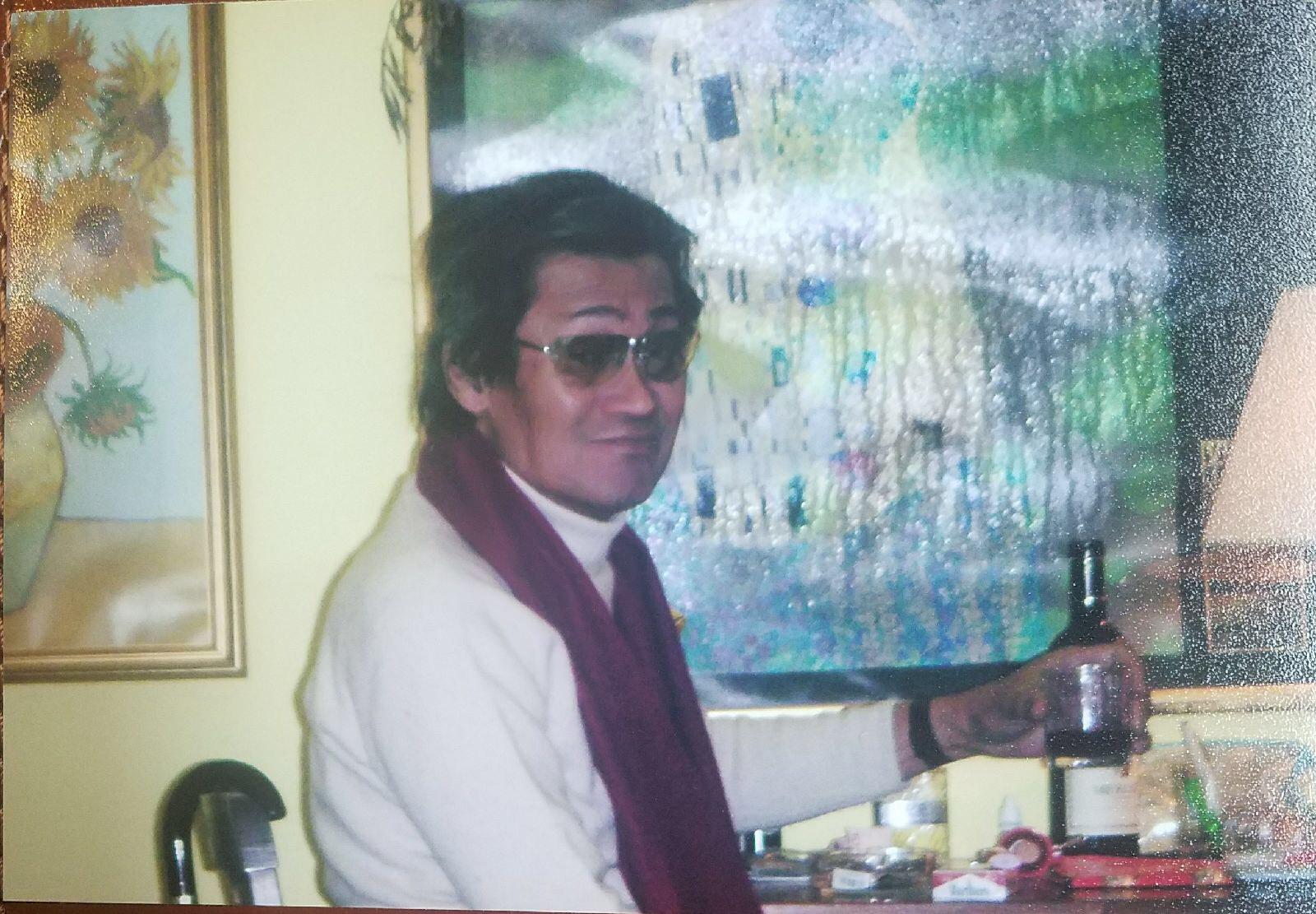
That first night, in 1959, he stepped off the train and crossed a near-deserted piazza with a suitcase in each hand, looking for signs of city life, no idea which direction would bring fortune. He came across a young railroad worker offering a guest room, for a small fee, in his apartment. Tomas went to bed that first night worried the young man might butcher him in his sleep.
By then, his five siblings were deep into leather-shoe careers in the Philippines or getting settled in the States. Born in Mindanao, the southernmost Philippine island, Tomas was the youngest among them and his parents’ least favorite. His father, a retired military postal commander, sometimes called him “three demons” because he was neither religious nor studious enough. They had a falling out after Tomas left his architectural studies to enroll in art school, first in Manila, then San Francisco, then Montreal. Eager to see how far his talents could take him, he continued eastward, to Europe, painting on the streets in Paris for six months, then in Marseille for a few days, before boarding the train to Rome, where he’d heard the art scene was vibrant.
He hustled his way forward. He spent most days, morning to night, at Piazza di Spagna, sitting on the steps at the base of a 16th-century church, watching people, painting them, and selling his work. With that money, he bought a studio nearby.
The first month had been lonely. The stares, from harsh or curious faces, heightened his sense of isolation. He got much attention for his looks, which some described to him as “exotic.” A few months in, a man approached him as he painted and asked if he wanted to be in a movie. The man promised good money, and when production began, the director, Federico Fellini, was so taken by the young brown man’s striking appearance — his intense eyes, high cheekbones, and chiseled jaw — that he cast him as an extra in three scenes, including one role that had him dancing in a gold bodysuit and another in which he wore a Thai pagoda. The film, La Dolce Vita, turned out to be popular, and more acting offers came Tomas’s way. His next role was as a native tribal chief in a movie called Adventures of the Tropics.
The novelty of Tomas’s appearance, and the mysterious history it implied, followed him as he ascended into Rome’s high society — the same questions asked after every hug and cheek kiss, leading to the same stories about his Spanish grandfather, who rode into a southern Philippine village on a horse and married the Muslim princess whose ancestors had resisted the Catholic colonizers for centuries. This was to be expected, Tomas believed. The cost of assimilation is always having to explain yourself.
“My new friends reminded me of children excited to hear a fable,” Tomas said. Often, he began his tale, “I am exotic because I was born under a coconut palm tree.”
But he didn’t mind having to educate: When his Western companions praised then-president Marcos, Tomas countered with stories of corruption and injustice, pounding the table as he held court.
“They didn’t know what I knew,” he said, pounding his patio table half a century later. “They didn’t know about the massacres. The obscene riches. The cronies. It was happening too far away for them to know the truth. I could not let that stand.”
“What did you tell them?” I asked.
“I told them Marcos was a murderer!”
His distance from his homeland had not diminished his militancy. Leaving did not mean forgetting or abandoning. To Tomas, those bonds forged at birth were permanent. “You know, after all these years, I’m still a Filipino citizen,” he said to me one day. “Fifty years I’ve lived in Italy, and still a Filipino citizen!”
Their generation had fulfilled their obligations, and I wondered if the obligation of my generation was to fulfill their ambitions.
Decades of his life had been a running negotiation between the world he had left and the one he had found, the obligations tugging him back and the ambitions thrusting him forward. In the immigrant stories I’d grown up with, the two motivations were always intertwined: The ambition was to fulfill the obligation, the sacrifice for family and future. My aunties, my uncles, my mother had left middle-class comfort in the Philippines to start from scratch in the boiler room of working-class America, in the hopes of gifting their children the luxuries of an American life. Their generation had fulfilled their obligations, and I wondered if the obligation of my generation was to fulfill their ambitions. To make their sacrifice worthwhile. But what did that mean?
Though far from his family, Tomas found in Italy a community, a tribe, a circle of friends and confidants sauntering in and out of his studio, crowding around tables in lively restaurants late at night, discussing art and politics and all the things Tomas was most interested in discussing. People to spend Christmas and New Year’s Eve with. “My solitude was over. My life had become an endless wave of affectionate greetings, warm embraces,” he said. “So many strange new people.”
He began wearing suits every day, abandoning the T-shirts and jeans that had once dominated his wardrobe. At dinner parties in his Rome apartment every Sunday, he cooked pancit and adobo for the starlets and leading men passing through the city, their presence on the block obvious from the collection of Ferraris, Maseratis, and Lamborghinis parked along the curb. King Constantine II of Greece was an occasional attendee — as was Josephine Baker, and I like to think she and Tomas had conversations about roles they were stuck playing as brown folks in Europe. Tomas was glad to no longer need the acting work.
With his proximity to the social upper crust, he was regularly commissioned to paint portraits of the wealthy, which granted him the financial stability to pursue his own projects, the work that would earn him exhibitions in museums and lucrative contracts for public statues. One day, an art collector introduced him to a potential client, Count Sebastiano Bonmartini, whose family had held power in the region for six centuries, stretching back to the time of the Medici dynasty.
Over hours of painting sessions, the men got close. Sebastiano invited Tomas to Bonmartini family gatherings, in opulent dining halls and on countryside terraces. His first few times amid the Roman nobility, Tomas felt intimidated. Their homes were so big, old, and extravagant, their traditions so deeply rooted, their standing unquestioned.
The success of this family seemed unbroken by time and cemented in place, layers upon layers of shared past, never having to start over from scratch even as borders shifted and flags changed. As I heard the stories, I couldn’t help but think about my own family. I imagined that the dream of every immigrant disembarking on new soil was to pave that first layer in the hopes of building something so permanent.
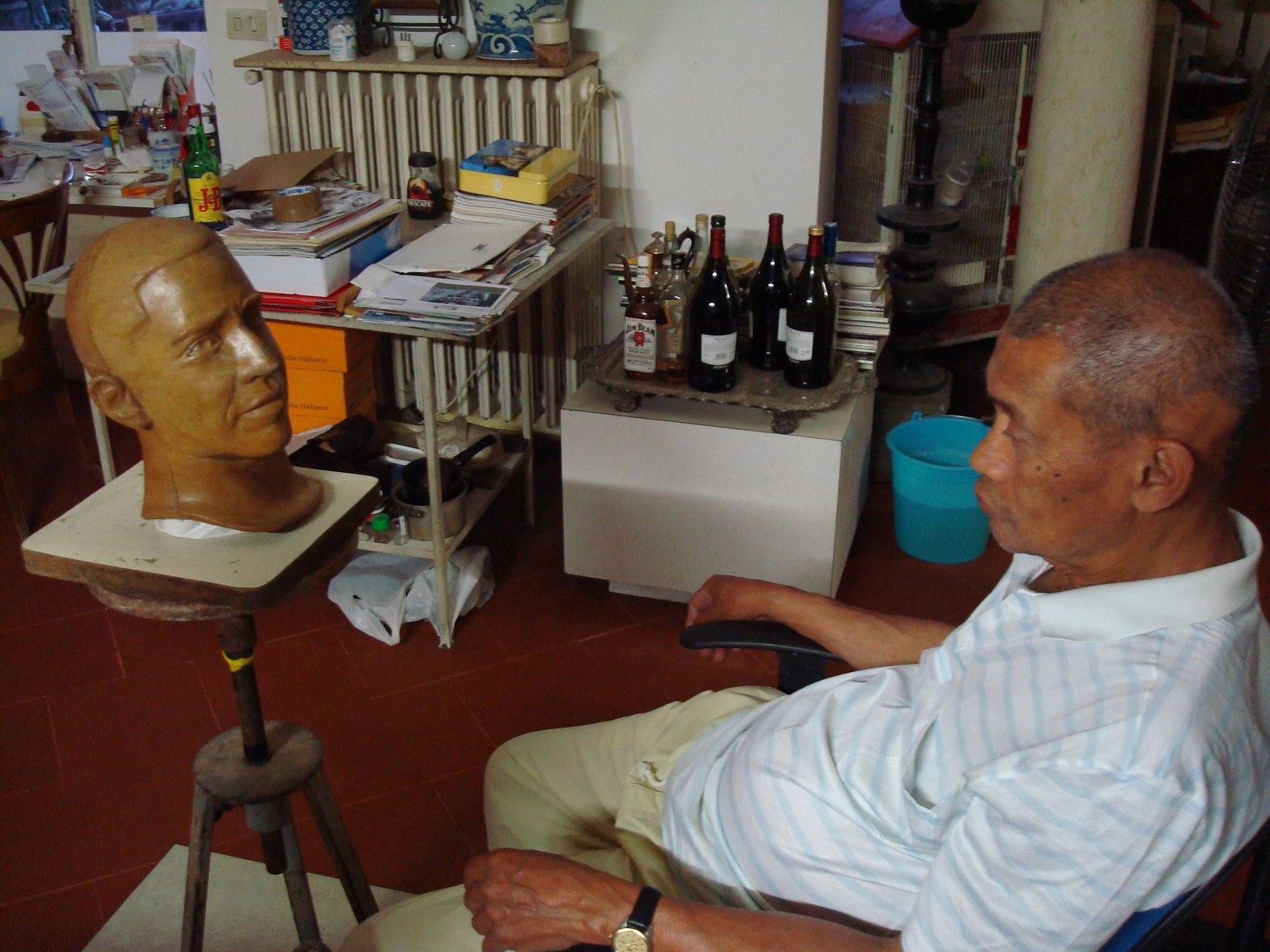
Several days before the end of my two-week visit, I fell ill. It came out of nowhere, a stabbing pain searing my gut one night, my stomach unable to hold anything down. I was sweating immensely, drained of energy, and could barely walk. My great-uncle and Ric helped me to the car and took me to the hospital. They dropped me off in front while they went to find parking, and I entered to find a nearly empty waiting room without any receptionist. I called out for help a few times, to no avail, before eventually just pretending to pass out, which successfully drew a pack of nurses.
Within minutes, I was on a bed, under lights. None of the nurses, nor the doctor on shift, spoke English. They were saying things to me in Italian that sounded urgent, and I urgently tried to describe my symptoms with a series of vague hand gestures. Back and forth we went. The only effective form of communication coming out of my mouth was the bile I was puking into garbage bags every couple of minutes. It was chaos — until my great-uncle arrived.
I heard the thump of his cane on the linoleum down the hallway, then his heavy, resonant voice outside my room. The nurses and the doctor greeted him with reverence; even the locals who didn’t know the famous Filipino artist living on their hill had at least heard of him. He spoke to the staff in Italian, to me in English, and to Ric in Tagalog, weaving in and out each of conversation, translating, asking questions, giving orders. A wave of relief passed over me. I was in my great-uncle’s domain, and he would make sure I was taken care of.
As I lay writhing, watching Tomas take command, I found myself filled with gratitude for this self-made man who’d built a life for himself in this foreign place. I’d never quite been sure of the duties that came with my privilege as a second-generation immigrant. I felt the pull of our family home, to stay, build, and strengthen the base that my mother’s cohort had established. To babysit nieces and nephews, attend every ceremony, take part in serious meetings over family affairs, raise children who saw their cousins as often as I saw mine. Simply, to be there. But an opposing force tugged at me, too — the impulse to leap beyond our ecosystem, expand our boundaries, open new worlds for the coming generations the way my great-uncle had for me.
He visited me on each of my three days at the hospital, bringing me books and updating me on the small progressions he’d made on the Obama bust. The doctor told us I had been struck with stomach inflammation of unknown origin, maybe something I ate. After I was discharged, my great-uncle and Ric picked me up in the old blue Volkswagen and we crisscrossed the town. It was a warm, clear day and people were out, carrying baskets of fruit, sipping espressos on tables that wobbled on the cobblestones, examining scarves and dresses laid out at a flea market. Ric had to weave around a pack of tourists strolling down the road that led to the castle villa. They raised their cameras to photograph the turret that towered above them, barely noticing Ric hop out of our car just behind them.
The metallic creak of the big iron door startled them, and by the looks on their faces they were surprised to see Ric, this short and strong Filipino, pulling open the heavy gate, his slippers barely gripping the pavement. As Ric eased the car into the driveway, I noticed the tourists peeking at our windows, seeking a glimpse of whoever called this place home.
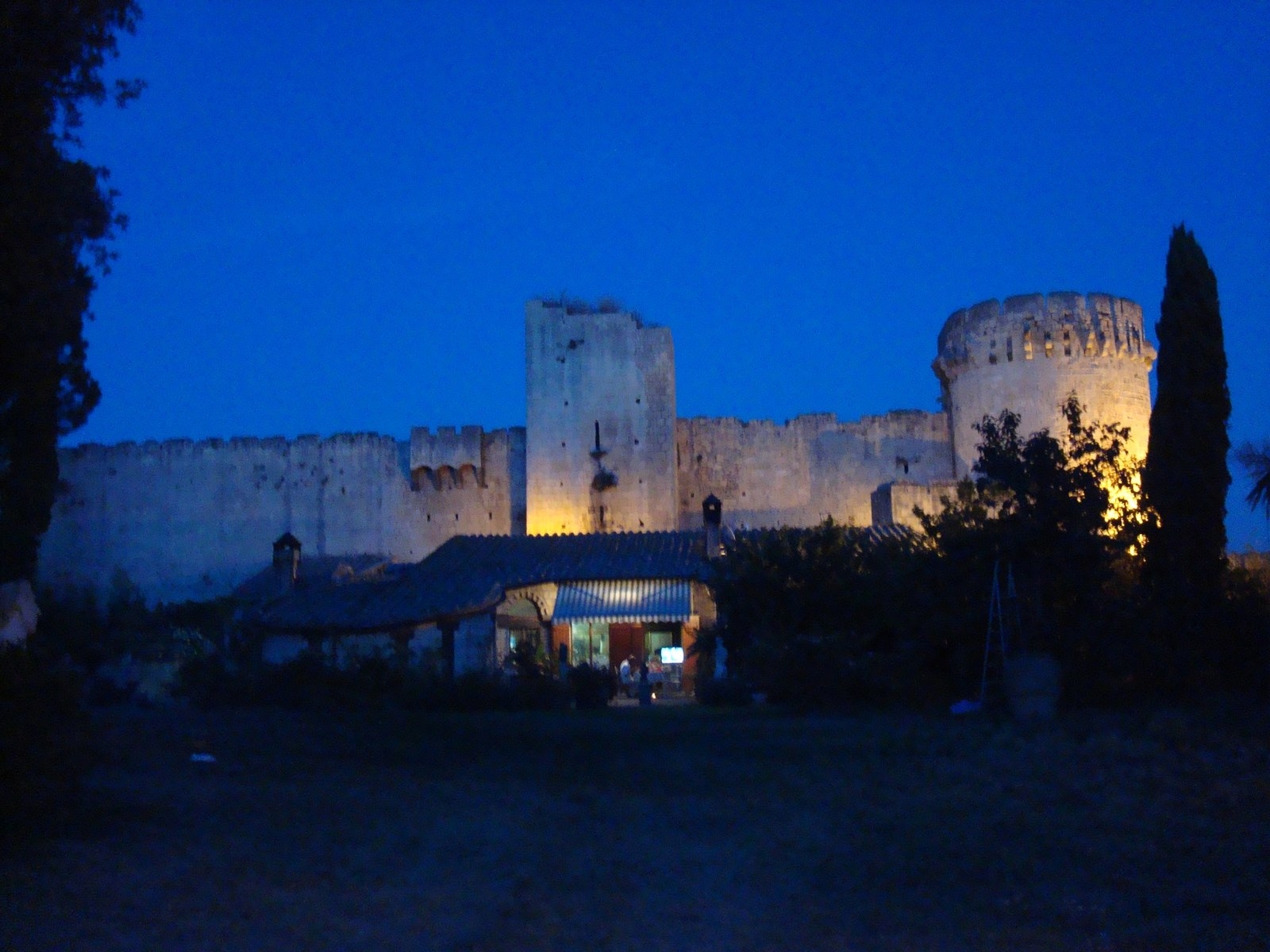
We spent those final few days back at work in the villa. By then, I had all the material I needed for my story, so I focused my energy on translating his memoir. On my last night in Tarquinia, Tomas invited me back, offering to hire me to help him finish the book.
Five months later, during my winter break, I returned — a smooth arrival this time. We completed the work ahead of schedule. The story I’d pitched about Tomas had been rejected by the Filipino weekly, so I began composing a new one, about a budding movement calling on the Philippines to reclaim islands that had been stolen by imperial powers long ago. That story, too, would be rejected, but as I wrote it, late at night on Tomas’s desk, I remember thinking that there was nothing else I’d rather be doing.
“I am an old man and can no longer wander,” he wrote, "so I will need to hear more of your adventures.”
By then, the Obama bust was bronzed and polished. Tomas said that he hoped to escort it to DC, and perhaps I could meet him there and accompany him to the White House. The plans were still up in the air when I returned to California that winter.
My great-uncle and I kept in touch after those two visits, exchanging letters. His came in cream-colored envelopes, the words in fine blue cursive, the paper thick and sturdy. He told me about the new computer he'd gotten, the latest books he’d read. He was excited to hear that I was moving to New York City — “a wonderful city!” — that summer for journalism school. The following year, after I moved to St. Louis for my first full-time writing job, he requested a full description of this city he’d heard of, but never visited. “I am an old man and can no longer wander,” he wrote, “so I will need to hear more of your adventures.”
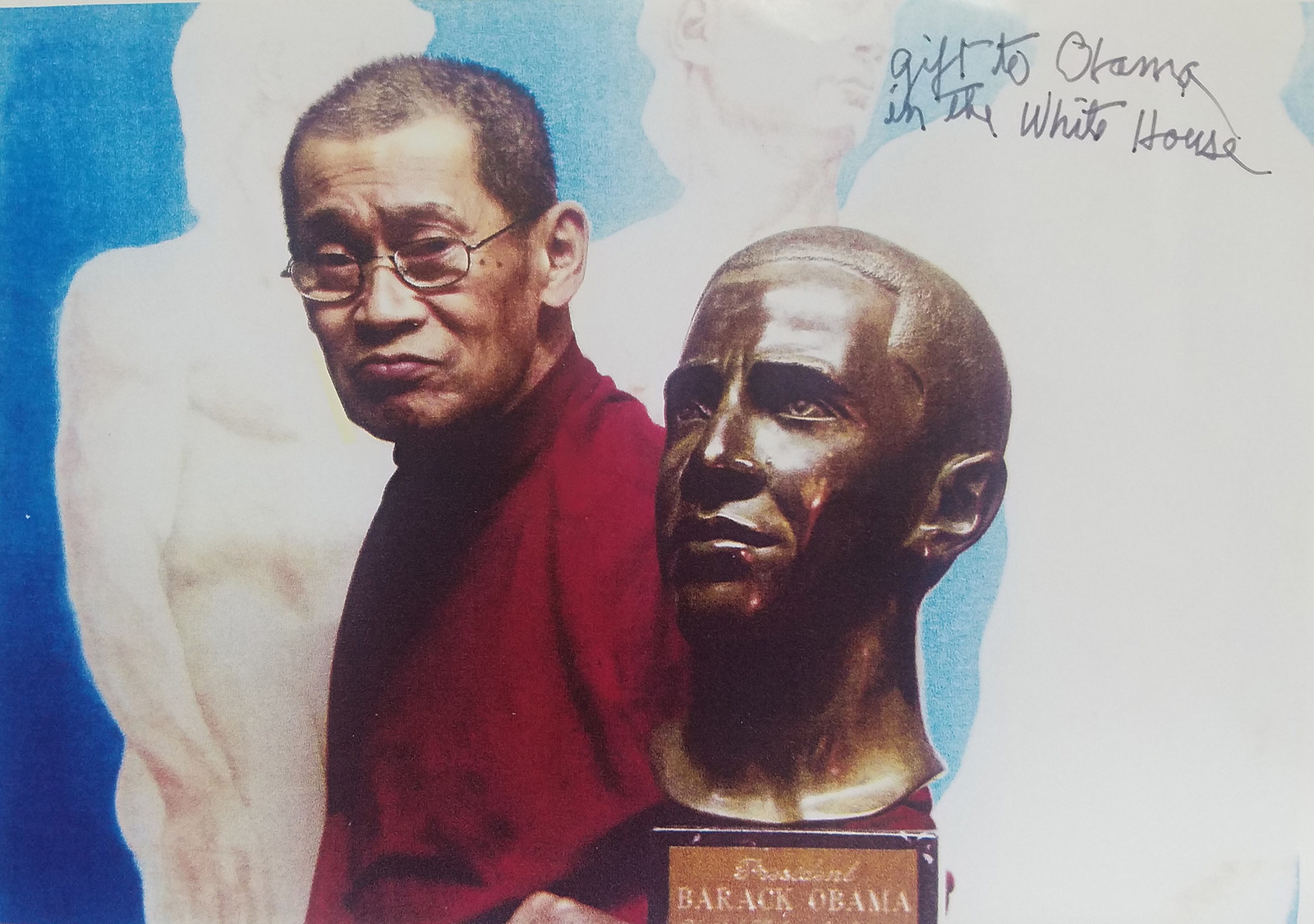
When my great-uncle died in May 2012, I’d been living in San Francisco for two months, working for an alt-weekly. We gathered in my auntie’s house in Vallejo to plan the next steps. With his death, the castle villa property returned to the Bonmartini estate, and our family had to figure out what to do with all of Tomas’s work and possessions. Though he’d lived in Italy for 53 years, he never had blood there.
A crew of my aunties and uncles made the trip, no less spontaneous than the one I’d made three years earlier. They collected valuables and planned to ship his artworks to California, where we’d store them in our homes while searching for a gallery to exhibit them. But there were just too many canvases and bronzes, too massive and too heavy, for our contingent to handle over their week in town. Most of his work remained scattered around the villa. The Obama bust sat on a desk, still waiting to be sent across the ocean.
When the aunties and uncles returned from Italy, we again gathered in Vallejo. At 23, I was the newest member of our family’s governing body, an adult in the room with a hand in our collective future. It was my first time living back in our little Northern California colony since I was in high school, and I found that it felt good to be around. I lived with my cousin in the house on Divisadero Street that belonged to Tomas’s sister. When I first moved in, I wondered if I’d returned for good. Was this my life now, here, under a roof that had belonged to my family for half a century? But I also wondered if I was succumbing to the burden that probably weighs on every immigrant family: You work so hard to claim a stake on this land that, once you have it, how can you do anything but protect it with all your might, no matter the cost?
Lucky for me, it wasn’t my cost to pay; it wasn’t two years before I left again. I could see that what we had built was going nowhere, that the strength of our many was more than enough to support the absence of one. And I was free to go and chase a Tarquinia of my own.
There were talks of a second, longer family trip to clear the property of Tomas’s work, but people needed to save money, find time, and coordinate schedules. The delays have lasted five years, though I couldn’t give you the details of those family discussions, because I live in New York now, and only get the headlines. Last I heard, we might try to make it out there this fall. But nobody’s booked a ticket yet. ●
This essay is part of a series of stories about travel.
